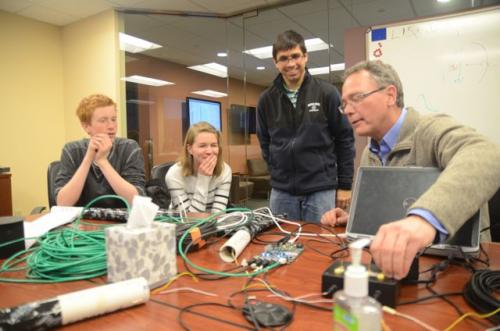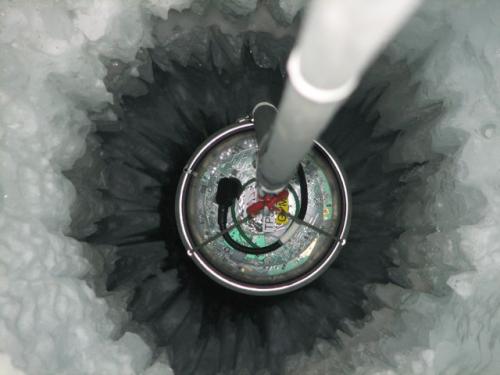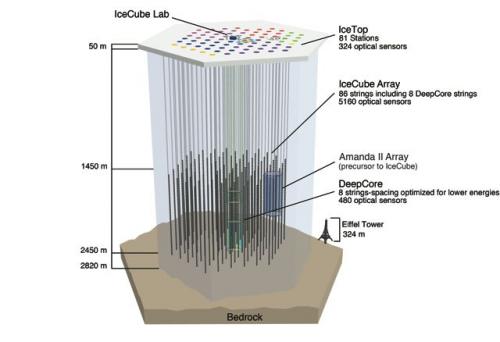How do you detect a tiny little particle, much smaller than an electron, that has barely any mass, and no charge? With an ice cube, of course!

We decided to use the IceCube project as our contribution to the project-sharing that will take place at Escudaro Station in Antarctica, so I thought I could write a summary here on this amazing project. I suggest you visit the following websites if you are interested on learning more about IceCube. Check out IceCube's website, and also the following PolarTREC teachers' websites that have had the opportunity to work with IceCube: Lizz Ratliff, and Katey Shirey.
The JASE team chose to share IceCube with students and teachers from Chile because it is an Antarctic project based in Madison, Wisconsin; next door to our high school. IceCube is actually an international project with 41 institutions participating from 12 countries. It is huge! We have had the luck to meet Dr. Jim Madsen, and his team, who generously have spent time working with us.

The idea behind IceCube is that there is this extremely small particle lurking the Universe, with barely any mass and no electrical charge, called neutrino. This particle is so close to being nothing that scientist call it "the ghost particle". Neutrinos are tiny, but quite common; trillions of them pass through your extended hand. The neutrino (from the Italian "small neutral charge") can help us explore many important questions in physics, if we are able to detect it. Scientists believe, for example, that neutrinos could help us understand why at the beginning of the Universe matter became more abundant than antimatter. We also believe neutrinos could help us elucidate what dark matter is. At the moment, we do not even know for sure where very high energy neutrinos originate in the Universe. Lower energy neutrinos are produced during fusion reactions that power stars, like our Sun, or more exotic stars like the neutron stars. Bursts of neutrinos come from the explosions of stars at the end of their life cycle, called Supernovae, and others from very violent explosions called Gamma Bursts. The challenge is that neutrinos are very elusive; with their extremely small mass and no charge, they barely interact with anything. If we build a sensor, the neutrino would just go through!
But when there is a will there is a way, so scientists figured out a cool way to detect them. Einstein showed with relativity that nothing can travel faster than light on empty space (vacuum). We say empty space because light slows down when it travels through a transparent medium, like water or ice. Since neutrinos do not interact much, they go through water and ice without changing their speed. This means that if they are close to the speed of light as they enter a block of ice, they will travel in the ice faster than light itself! It turns out that when charged particles travel faster than light in a transparent medium, that charged particle gives of a tiny bit of light. This is called Cherenkov radiation.
If you want to detect charged particles that are traveling faster than the speed of light in ice, all yo have to do is to place a light sensor inside the ice that is kept in complete darkness. The sensor will detect the Cherenkov radiation from that speedy particle. But this light sensor is not an ordinary light sensor like the ones you can buy at Radio Shack. You need a much more sensitive one. IceCube calls its detectors Digital Optical Modules, or DOMs. If you want to know the direction from which the particle came from, you need more than one DOM in the ice so you can compute the time delay between the detection by both sensors.

"Wait a second!" you might say. "Didn't you say that neutrinos have no charge, and that Cherenkov radiation is given by charged particles traveling faster than light on a transparent medium?" You are quite right, neutrino detection is not that easy. Neutrinos do not give Cherenkov radiation even when they travel faster than light inside the ice because they have no charge, but they can generate other charged particles that travel at the same speed when they interact with matter. Remember we said neutrinos barely interact with matter? The key is in the barely. Out of those trillions of neutrinos that just went through your hand, about every hundred years or so, one will hit the nucleus of an atom. A bunch of other subatomic particles come out of this high speed collision, muons among them. The benefit is that the muon has a negative charge and thus will emit Cherenkov radiation in the ice; the DOM's are be able to detect the light and track the muon. Bottom line, scientists detect neutrinos from outer space by detecting the debris that forms when they crash into bigger particles inside the ice. Since neutrinos do not crash often, we better put a lot of DOMs in a very large chunk of ice if we want to detect those crashes.
Here is a question for you, where would you build a neutrino detector? Let's see; we need a very large chunk of very clear ice, one that has no bubbles, that stays in complete darkness so the DOMs detect only the Cherenkov light. We need to keep the ice for many years without melting. A large freezer anyone? Mmmm, how about the South Pole? Yes!, the South Pole is the ideal location! Even in the South Pole, in order to have very clear ice and very dark, we need to put the DOMs about 1450 m below the ice surface. That is just short of a mile!
The neutrino detector at South Pole is a cube of ice of one square kilometer of area and one kilometer of depth (1 cubic km) that starts, as we said before, 1450m below the surface. It has 5160 DOMs in 86 vertical strings. The question is, how did they embed all those sensors in the ice more than two kilometers below the surface? Easy --- just the way you would poke holes on a large chunk of ice --- with hot water. They used hot water drills that poke more than two kilometers deep vertical holes on the ice. A string with DOMs was then lowered into position. Can you imagine drilling in ice 86 holes of more than two kilometers deep, just with hot water, in one of the remotest and coldest part of the world? What an achievement of technology! How I wish I could visit the observatory.

In summary, IceCube does not study Antarctic processes, but uses the Antarctic environment for studying the cosmos. The observatory is functioning well, and scientists from all over the world are happily working on the data to uncover more mysteries of our Universe. But don't you worry, there will be plenty mysteries waiting for you to uncover if you decide to become a scientist!
Sobre cubitos de hielo
¿Cómo detectarías una partícula pequeñísima, mucho más pequeña que un electrón, que apenas tiene masa, y no tiene carga eléctrica? Con un cubo de hielo, ¡sin duda!

Decidimos usar el proyecto IceCube (cubo de hielo) como nuestra contribución a las presentaciones que los estudiantes chilenos darán en la Estación de Investigación Escudero, en la Antártida, por lo que pensé que sería bueno explicar aquí este maravilloso proyecto. Sugiero que si te interesa aprender más sobre IceCube, que visites las siguientes páginas: Desde luego la página de IceCube's, así como las páginas de maestras PolarTREC que han tenido la fortuna de trabajar con IceCube Lizz Ratliff, and Katey Shirey.
El grupo JASE escogío compartir el proyecto ICeCube con los estudiantes chilenos porque en un proyecto de investigación que se realiza en la Antártida y porque su base principal está en la ciudad de Madison, Wisconsin. De hecho, IceCubo es un proyecto internacional en el que participan 41 instituciones de 12 países, ¡es enorme! Hemos tenido la suerte de conocer al Dr. Jim Madsen y a su equip, quienes generosamente nos han brindado mucha ayuda.

La idea en la que se basa IceCube es que existe en el universo una partícula extremadamente pequeña con apenas una pizca de masa y sin carga eléctrica. Esta partícula está tan cerca de no ser nada, que los científicos la llaman la “partícula fantasma”. Son realmente pequeñas, pero comunes y abundantes; un billón (millón de millones) de ellas pasan por tu mano extendida. El neutríno (del italiano “pequeña carga neutral”) nos puede ayudar a explorar muchas preguntas importantes de la física, si podemos detectarlo. Los científicos creen, por ejemplo, que los neutrinos nos pueden ayudar a comprender porqué en los orígenes del universo la materia se volvió más abundante que la antimateria. También creemos que los neutrinos nos podrían ayudar a elucidar que es la materia oscura. De momento, no sabemos siquiera el orígen en el cosmos de los neutrinos de gran energía. Los neutrinos de baja energía se generan en las estrellas, como el sol, durante la fusión atómica, y en estrellas más exóticas como las estrellas de neutrones. Algunas ráfagas de neutrinos provienen de las supernovas, explosiones que sufren ciertas estrellas al final de su vida, y otras de las explosiones violentas conocidas como Gamma Bursts (Brotes de Rayos Gamma). El problema es que los neutrinos son muy esquivos; con su masa tan pequeña y sin carga eléctrica, apenas interactúan con otras partículas. Si pudiéramos construir un sensor, éstos pasarían a través de él.
Pero cuando se quiere se puede, así que los científicos diseñaron una forma muy interesante para detectarlos. Einstein nos enseñó mediante su teoría de la Relatividad, que nada puede viajar más rápido que la luz en el vacío. Es necesario especificar “en el vacío” ya que la luz se frena un poco al pasar por medios transparentes, como puede ser el agua o el hielo. Como los neutrinos no interactúan mucho, viajan por el agua y el hielo sin cambiar su velocidad. Esto quiere decir que si viajan casi a la velocidad de la luz antes de entrar a un bloque de hielo, ¡ellos pueden viajar más rápido que la luz en ese hielo! Resulta que cuando partículas con carga eléctrica viajan más rápido que la luz en un medio transparente, éstas emiten una luz tenue. A esta luz se le llama radiación Cherenkov.
Si quieres detectar partículas con carga eléctrica que viajan más rápido que la luz en el hielo, lo único que tienes que hacer es poner un detector de luz en el hielo a oscuras. El sensor detectará la radiación Cherenkov emitida por la partícula veloz. Pero este detector de luz no es un detector ordinario como el que podrías comprar en Radio Shack. Necesitas un detector mucho más sensible. Los detectores de IceCube son llamados Módulos ópticos Digitales, o DOM por sus siglas en inglés (Digital Optical Modules). Si quieres saber la dirección de la que proviene una partícula, necesitas poner muchos DOM y medir la diferencia en tiempo en que registraron los DOM.

“Espera un momento”, podrías decirme, “¿no quedamos en que los neutrinos no tienen carga eléctrica, y que se necesita una partícula con carga para producir la radiación Cherenkov?” Tienes toda la razón; la detección de neutrinos no es tan sencilla. Efectivamente, los neutrinos no dan radiación Cherenkov aún cuando viajan más rápido que la luz en el hielo ya que no tienen carga eléctrica, pero pueden generar otras partículas con carga cuando chocan con el núcleo de algún átomo. ¿Te acuerdas que dijímos que los neutrinos apenas interactúan con otras partículas? La clave está en el “apenas”. Del billón de neutrinos que acaban de pasar por tu mano, uno de ellos choca con un átomo en cien años. A partir de este choque de alta velocidad salen un montón de otras partículas subatómicas, como el muon. Lo bueno de los muones en este caso, es que éstos si tienen carga negativa, por lo que emiten radiación Cherenkov en el hielo; los DOM son capaces de detectar est tenue luz y seguir a los muones. En resumen, los científicos detectan neutrinos del cosmos al detectar los escombros que se generan cuando los neutrinos logran chocar con partículas más grandes en el hielo. Es necesario poner muchísimos DOM en un pedazo enorme de hielo para detectar los neutrinos debido a que estas colisiones son muy pero muy escasas.
Ahora una pregunta para tí, ¿dónde construirías un detector de neutrinos? Veamos, se necesita un enorme trozo de hielo muy claro, sin burbujas, en oscuridad total para que los DOM sólo detécten la luz Cherenkov. Necesitamos que el hilo se mantenga sin derretir por muchos años. Un gran congelador, ¿acaso? Mmmm, ¿qué te parece el Polo Sur? ¡Así es!, el Polo Sur es el lugar ideal. Aún en el Polo Sur, se necesita poner los DOM a una profundidad de 1450 metros para alcanzar el hielo claro y oscuro, ¿te imaginas?
El detector de neutrinos en el Polo Sur es un cubo de hielo de un kilómetro por lado, que empieza, como dijimos antes, a una profundidad de 1450 metros. Teine 51600 DOM an 86 cables verticales. La pregunta es, ¿cómo le hicieron para incrustar los sensores amás de dos kilómetros de la superficie? Sencillo --- igual que le harías tú para horadar un bloque grande de hielo --- con agua caliente. Utilizaron taladros de agua caliente para perforar el hielo y hacer hoyos de más de dos kilómetros de profundidad en el hielo. Después colocaron un cable con los DOM en cada agujero. ¿Te imaginas perforar en el hielo con agua caliente 86 hoyos de más de dos kilómetros de profundidad en uno de los lugares más fríos y remotos del mundo? ¡Que gran logro tecnológico! Cómo me gustaría visitar el observatorio.

Después de todo, IceCube no estudia los process antárticos; utiliza las condiciones antárticas para estudiar el cosmos. El observatorio se encuentra funcionando bien, y ahora hay un montón de científicos de todo el mundo felices de poder resolver meas misterios del universo. Pero no te preocupes; quedarán muchos misterios por resolverse en caso de que te decidas a ser un científico.


Comments